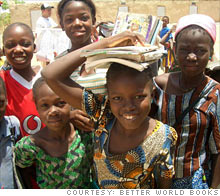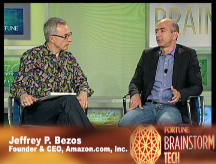Better World's books talk back
A cult online bookstore builds a loyal following on a shoestring.
 |
| Better World has donated more than $1 million to nonprofit Books for Africa. |
 |
| Co-founders Christopher Fushs, left, and Xavier Helgesen are up to their necks in books. |
 |
| An employee packs orders at the company's 2-million-book warehouse in Mishawaka, Ind. |
(Fortune Small Business) -- Buying books on the Internet involves a familiar procedure: Browse, add to cart, check out and await delivery. So when Christy Mann, a third-year student at Wesleyan College in Macon, Ga., placed an order on the Web site betterworldbooks.com, she was surprised to receive an e-mail that purportedly came from the used book she'd just purchased.
The book complimented her choice, thanked her profusely for saving it from a landfill and rhapsodized about the journey it was about to undertake, from warehouse to doorstep. "Okay, I officially love Better World Books now," she wrote back. "This e-mail made me laugh, showed me you cared and won you a new loyal customer."
The past decade has seen an explosion of online book resellers, especially since Amazon (AMZN, Fortune 500) offered them a place on its pages in 2000. Conventional wisdom has it that booksellers stand out if they undercut the competition, build flashy Web sites or pay for targeted online advertising. But Xavier Helgesen, co-founder of Better World Books, didn't buy those strategies. He couldn't: His company took no external funding for the first five years of its life. "We're not going to outmarket Amazon or Barnes & Noble (BKS, Fortune 500)," says Helgesen, 30. "So we differentiate ourselves by our interaction with customers."
Founded in 2003 by Helgesen and his Notre Dame college buddies Jeff Kurtzman and Christopher Fuchs, Better World bills itself as a for-profit company with a philanthropic and environmental edge. Some of its books are new, others secondhand; the majority are donated by schools and libraries. A portion of the proceeds goes toward nonprofit literacy programs. So far, the company says, it has raised upward of $5 million for the programs and prevented more than 16.5 million books - or 8,000 tons of pulp - from winding up in landfills. And Better World isn't shy about letting its customers know that. Those numbers are trumpeted in large type at the top of the Web site and updated in real time.
Better World now sells 6,000 books a day. More than half of all orders come from repeat customers. In 2008 revenues rose 40% to $21 million, and the company aims to hit $31 million this year.
Compared with some of its competitors, Better World's revenues are modest. For example, Half Price Books, a Dallas vendor that sells new and used books on Amazon and at 103 brick-and-mortar outlets, had revenues of $186 million during its 2008 fiscal year, which ended June 30. Kathy Doyle Thomas, executive vice president of Half Price Books, says her company has an edge on Better World because it pays cash for used books, rather than relying on donations. "The public has definitely responded positively," Thomas says. "In this economy people are happy to get any amount of money."
But Better World is on the rise. In January of this year it raised $4 million in equity capital - the company's first-ever round of funding.
"We've grown on a very scrappy budget," Helgesen says. "It was tough to find investors who wanted to help us build a profitable company without sacrificing our social and environmental aims."
Investors weren't the only ones to express skepticism. One of the judges who reviewed - and panned - Helgesen's initial business plan during Notre Dame's 2003 Social Venture Business Competition remembers questioning how a company like Better World could both grow and stay true to its social mission. "We speculated that they may start making money as a book reseller and drift away from their founding principles," Mike Reardon recalls.
Since then, Reardon admits, Better World has created a sustainable business model, which he says is rare among for-profit businesses with philanthropic aims. Helgesen credits the company's success to its customer service.
Given the company's focus on consumers, it may come as a surprise that Better World does not publish its phone number on the Web site. Helgesen claims that too is because of budget constraints. "There are other places where we can use our money more effectively," he says, adding that he hopes to have the resources for a customer service line within two years.
For now, customer queries are answered by e-mail, as personally as possible. Meanwhile, Helgesen and the crew have focused on building a client base via social networks, online video and a blog. They have persuaded nearly 8,000 Facebook users to become "fans" of Better World. Last December those fans were offered the chance to win $5 gift certificates every day by answering such literary questions as "Who is the actual narrator in the novel Frankenstein?"
"We're cheap," admits Helgesen, "but we got more people signed up as fans because they thought it was fun."
Better World's YouTube page has been less successful. The company posted 14 homemade videos on the site, including testimonials from children enrolled in the literacy programs it helps fund. But most of the videos have been viewed fewer than 1,000 times each. The most successful one, with more than 4,000 views, is an animated feature about a talking used book that's down on her luck. Cast aside by a previous owner, she feels lonely - until another talking book persuades her to put her profile on Better World's Web site, where she'll surely find an owner who will read her the right way and never want to put her down.
Viewers gave it a five-star rating. Says Helgesen: "It's a simple way to communicate what we're about, which is being real people and not just a faceless Web site."
Correction: An earlier version of this story gave Better World Books' 2008 revenue as $24 million. The correct figure is $21 million. ![]()
Light a store, save a town
Save cash: Download your textbooks
-
The Cheesecake Factory created smaller portions to survive the downturn. Play
-
A breeder of award-winning marijuana seeds is following the money and heading to the U.S. More
-
Most small businesses die within five years, but Amish businesses have a survival rate north of 90%. More
-
The 10 most popular franchise brands over the past decade -- and their failure rates. More
-
These firms are the last left in America making iconic products now in their twilight. More









